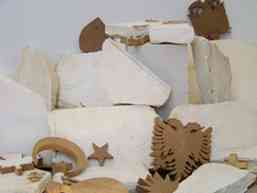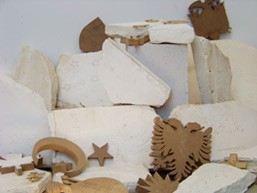Thomas Klimowski
Thomas Klimowski is an Astérides Resident in 2009 and 2010. The archives of Triangle-Astérides do not allow for the determination of the exact dates or the duration of this residency in 2009 and 2010.
Thomas Klimowski was born in 1978 in Paris (FR), he lives and works in Lyon (FR)
If the invention of perspective in painting contributed to the development of a theory of landscape, why shouldn’t the latest developments in this field have, in turn, influenced artistic practices? Since the 1970s, especially with the work of philosopher Alain Roger, the reflection on landscape has evolved significantly: it is now clear that the concept of landscape does not exist everywhere, nor at all times, and that it is, in fact, a cultural construction. Thomas Klimowski seems to have clearly understood the role of social subjectivity in the relationship to territory, as defined in sociology as the “geography of representations.”
In the installation Polonia (2006), the title is placed like a sign on a metal frame, surrounded on the ground by wooden planks, with archipelagos arranged randomly. Polonia is a term derived from the Latin roots of the word Poland, referring to the Polish diaspora scattered worldwide at a time when the country no longer existed, annexed by neighboring powers. The sign, therefore, represents a mental territory, bringing together the fantasies of a shared memory, with the wooden squares arranged around it functioning as scattered puzzle pieces. Among these, a lightbox displays a photograph of a highway interchange, extending the concept of a “non-place,” a shared horizon whose path is less about rediscovery than about reinvention.
The same principle of a mental territory, like a fragmented puzzle, is also evoked by J’aimerais revoir les cactus en fleur (2006), composed of canvases of different sizes in earth tones and ochres, stretched by cables, forming the metonymy of a landscape. Here, the monochrome is paradoxically linked to the principle of viewpoint, or “venduta,” revisiting abstraction through the spatial representation of a map.
In Dérives (2006), the idea of a puzzle seems to incorporate the subjective and mobile vision brought to cartography by new technologies. The possibility of moving a space composed of wooden “plots” signifies the mutations of a territory and the artifice of borders, while the photographic representation of this composition viewed from above, like a map, freezes the multiplicity of viewpoints to create the illusion of controlling a space.
The generic nature of the various elements in this landscape can certainly evoke pictorial compositions of the abstraction of the avant-gardes, but it is no longer about constructing internal autonomy in the painting. Instead, it signals the partial nature of all cartography and the transitional character of its meaning. The monochrome thus assumes a warrior-like character (in another installation, where it is mounted on spears) in the face of a social and artistic context dominated by the effectiveness of the “message.”
This exhaustion of signs is further evident in Panneaux (2006), where advertising panel modules found along roads outline the lines of a generic landscape (with layers of different woods) in a cinematic manner, accentuated by the lighting from below and the array of panels in the space. Klimowski also seeks to test the notions of territory and boundary by transposing them onto the geometry of a soccer field, dividing one of the two sides in half repeatedly, until reaching the absurdity evoked by the title Balkanisme (2008), when a conflict fractures into multiple conflicts. By invoking both the avant-gardes of modernism and the imagination of popular culture, Thomas Klimowski interrogates how geography and the limits of its abstract transposition (color codes, flatness) can conceal a geopolitics.
Text by Pedro Morais, March 2009
Thomas Klimowski’s work in on display during the exhibition Après avoir tout oublié [After having forgotten everything], 2015.



